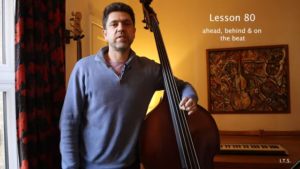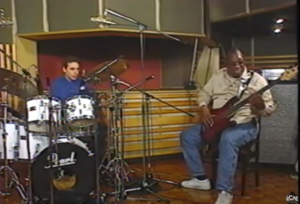CHAPTER 4: ACCOMPANYING VOCALISTS VS. INSTRUMENTALISTS(ボーカリストとインストゥルメンタリストの伴奏)
A fundamental question in many discussions about jazz vocal accompaniment is: should a pianist accompany a vocalist differently than an instrumentalist? Due to the visceral nature of the voice as opposed to the somewhat mechanical nature of an instrument, an accompanist might respond and react to the two in a different manner.
ジャズのボーカル伴奏に関する多くの議論において、基本的な問題の1つは、ピアニストはボーカリストとインストゥルメンタリストの伴奏を異なる方法で行うべきかということです。声の本能的な性質と、ある程度機械的な性質を持つ楽器との違いにより、伴奏者は2つのものに異なる反応や対応をする可能性があります。
Pianist Bill Charlap is often asked if there is a difference between playing for a vocalist and playing for an instrumentalist. For Charlap, “there is no difference. You listen for what the music asks, and then react intelligently in a way that gives the singer or soloist the space to express themselves.”29 I partially agree. While it is true that one must react intelligently and musically no matter what the accompaniment situation, other factors such as the awareness of the lyrics and the inherent limitation of breathing while enunciating words come into play while working with a vocalist. A pianist must make different accompaniment decisions when faced with these added elements. The challenge can be extremely rewarding, though, and makes the player a better overall accompanist.
ピアニストのビル・シャーラップは、しばしば「ボーカリストとインストゥルメンタリストのために演奏するときに違いがあるのか」と尋ねられます。シャーラップにとって、「違いはありません。音楽が求めるものを聴き、歌手やソリストが自己表現するためのスペースを与えるように、知的に反応するだけです。」私は部分的に同意します。伴奏の状況に関わらず、知的に音楽的に反応する必要があることは真実ですが、歌詞の認識や言葉をはっきりと発音する際の息を止める必要性など、他の要素も考慮する必要があります。これらの要素が加わると、ピアニストは異なる伴奏の決定をしなければなりません。このような挑戦は非常にやりがいがあり、演奏者を全体的に優れた伴奏者にすることができます。
Pianist Tommy Flanagan also saw a difference accompanying instrumentalists and vocalists. Flanagan accompanied many instrumentalists including famous tenor saxophonists Sonny Rollins and John Coltrane but also spent much time with vocalist Ella Fitzgerald. Flanagan once noted, “I couldn’t play behind her the same way I would behind a horn. Horn players would play the changes, but Ella, who is a very good musician, was more into a fixed melody. You get to the point where she expects certain arranged things.”30 On another occasion, Flanagan pointed out that working with Fitzgerald required more subtlety. He was careful not to overplay or provide a musical accompaniment that was not “out of her context. That’s what you have to think about when you accompany.”31 Finally, Flanagan conceded that when Ella sang ballads, he couldn’t “go into a lot of alternate changes like you would with a horn . . . When you’re stickin’ to a lyric and melody line, you have to stick pretty close to the pattern of the song.”32
ピアニストのトミー・フラナガンは、インストゥルメンタリストとボーカリストを伴奏する際に違いがあると見ていました。フラナガンは、有名なテナーサックス奏者であるソニー・ロリンズやジョン・コルトレーンをはじめとする多くのインストゥルメンタリストと共演してきましたが、同時にボーカリストのエラ・フィッツジェラルドとも多くの時間を共に過ごしました。フラナガンはかつて、「彼女の後ろで演奏するとき、ホーンの後ろで演奏するのと同じようにはできなかった。ホーン奏者はコード進行を演奏するのに対して、非常に優れたミュージシャンであるエラは、ある程度の固定されたメロディーに注力していた。彼女が特定のアレンジを期待するようになったポイントがあります」と述べました。また、別の機会に、フラナガンは、フィッツジェラルドとの仕事にはより微妙なアプローチが必要であると指摘しました。彼は、彼女のコンテキストから外れた過剰な伴奏を提供しないように注意しました。「あなたが伴奏するときにはそう思わなければなりません」と彼は述べました。最後に、フラナガンは、エラがバラードを歌うとき、ホーン奏者と同じように多くの変化を加えることができなかったと認め、「歌詞とメロディーラインにしっかりと沿う必要がある」と述べました。
Most pianists interviewed for this project distinguished between accompanying singers and accompanying instrumentalists. John di Martino asserts that one difference between playing for a vocalist versus an instrumentalist is that, when accompanying a vocalist, a pianist should play more orchestrally: “I’m always thinking of framing the melody in an orchestral way and creating an orchestral environment for the singer.” diMartino also notes that for instrumentalists he plays more rhythmically, depending on the rhythmic activity level of the soloist.
このプロジェクトでインタビューされた多くのピアニストは、歌手と楽器奏者を伴奏することの違いを区別していました。ジョン・ディ・マルティノは、ボーカリストを伴奏する場合と楽器演奏者を伴奏する場合の違いの1つは、ピアニストがオーケストラ的な演奏をする必要があることだと述べています。「私は常にメロディをオーケストラ的にフレーミングし、歌手のためのオーケストラ環境を作り出すことを考えています」とディ・マルティノは言います。また、ディ・マルティノは、楽器奏者に対しては、ソロ演奏者のリズム活動レベルに応じてよりリズミカルに演奏すると述べています。
When accompanying vocalists, Randy Halberstadt states he “tends to play more in between their phrases, so as to allow the lyrics to be better heard. But I also try to do that with horn players, just not so much.” John Colianni states that adjusting to the horn and the voice is a conditional process, dependent upon the situation and the singer: “Some vocalists can be great, but still need to be led to cue pitches and rhythms, unlike most good horn players, who shouldn't need that kind of guidance. Plus, depending on the singer, there is a lot more potential for variation in dynamics - loud to soft.”
ボーカリストを伴奏する際、ランディ・ハルバースタットは、「フレーズの合間で演奏することが多く、歌詞をより良く聞き取れるようにします。ただ、ホーン奏者に対しても同じことを試みますが、そうではない場合があります。」と述べています。ジョン・コリアーニは、ホーンと声に合わせることは、状況や歌手に依存する条件付きのプロセスであると述べています。「いくつかのボーカリストは素晴らしいかもしれませんが、音高やリズムを合わせるために導かれる必要があることがあり、ほとんどの優れたホーン奏者にはそのような指示が必要ないはずです。また、歌手によっては、ダイナミクスの変化がより多くあります - 大きな音から小さな音へと。」
Christian Jacob claims that the disparate natures of the horn and the voice dictate a different approach for each: “A horn plays very differently than a singer. You always want to support what the other is saying or doing. Comping33 for a horn will often be complementing his groove, or complementing his lyricism. I always wonder: what is he trying to communicate?”34
クリスチャン・ジェイコブは、ホーンと声の異なる性質がそれぞれ異なるアプローチを必要とすると主張しています。「ホーンは歌手とはまったく違う演奏方法があります。常に相手の言っていることややっていることを支援したいと思います。ホーンに対するコンピングは、彼のグルーヴやリリシズムを補完することが多いです。私は常に、彼が何を伝えようとしているのかと疑問に思います。」
David Newton mentions horn players are more likely to embellish and develop melodies more than a vocalist. This leaves less room to comp, but if the soloist plays busier ideas, that would influence Newton in a different way than working with the singer, perhaps inspiring him to play more rhythmically and harmonically inventive. Like di Martino, Newton thinks and plays “more orchestrally as opposed to a small group concept” when working with singers.
デイビッド・ニュートンは、ホーン奏者がボーカリストよりもメロディを装飾したり発展させたりすることがより多いと述べています。これにより、コンピングの余地は少なくなりますが、ソロイストがより忙しいアイデアを演奏する場合、それは歌手と一緒に働く場合とは異なる方法でニュートンに影響を与え、おそらく彼をリズミカルかつ和声的により創造的に演奏するように刺激することになるでしょう。ディ・マルティノと同様、ニュートンは、歌手と一緒に働くときには、「小規模グループコンセプト」とは異なり、「オーケストラ的により考え、演奏する」ことが多いと考えています。
With vocalists, Eric Gunnison often plays more spread voicings, or voicings with widely-spaced intervals, such as chords with stacked fifths (C-G-D-A-E). This allows more space and breathing room for the vocalist. He also uses fewer clusters35 for the same reason. He comps less aggressively overall. Similarly, Larry Dunlap plays less when accompanying a vocalist than he would with a horn or when playing in an instrumental group. If the vocalist is more experienced Dunlap is more adventurous melodically, but still plays fewer notes than he would for an instrumentalist.
ボーカリストと一緒に演奏する場合、エリック・ガンニソンは、しばしばスプレッド・ボイシング(音程が広く離れたボイシング)を使用します。たとえば、スタックしたフィフス・コード(C-G-D-A-E)などです。これにより、ボーカリストに余裕と息抜きのスペースを与えることができます。また、同じ理由で、彼はより少ないクラスターを使用します。全体的にコンピングはより控えめに行います。同様に、ラリー・ダンラップは、ボーカリストを伴奏する場合、ホーンや楽器グループで演奏する場合よりも、演奏する音数を減らします。ボーカリストがより経験豊富であれば、ダンラップは旋律的により冒険的になりますが、それでも楽器奏者に比べて演奏する音数を減らします。
Hobgood does not necessarily divide horn players and singers into two distinct categories. He accompanies a soloist based on timbral considerations instead of the nature of the instrument. Hobgood has much to say about the special skills necessary when working with vocalists. These tools are examined in later chapters.
ホブグッドは、ホーン奏者と歌手を2つの明確なカテゴリに分ける必要はありません。彼は楽器の性質よりも音色の考慮に基づいてソロイストを伴奏します。ホブグッドは、ボーカリストと一緒に仕事をする際に必要な特別なスキルについて多くを語っています。これらのツールについては、後の章で詳しく説明します。
Although their approaches differ, the majority of the pianists interviewed for this project agree that there is a marked difference between accompanying an instrumentalist and accompanying a vocalist. With this established, it is important to identify the specific issues that face the accompanist when working with vocalists that may not arise when working with instrumentalists. The subsequent chapters will attempt to address these issues by investigating specific musical devices a pianist uses with vocalists, and determine if there is a consensus among the participants.
このプロジェクトのインタビューを受けたピアニストの多くは、アンサンブル演奏する楽器奏者とボーカリストと一緒に演奏することの違いを認めています。これが確立されたら、ボーカリストと一緒に仕事をする際に生じるかもしれない、楽器奏者と一緒に仕事をするときには生じない特定の問題を特定することが重要です。次の章では、ピアニストがボーカリストと一緒に使用する特定の音楽的デバイスを調査し、参加者間に合意があるかどうかを確認することで、これらの問題に対処しようとします。

